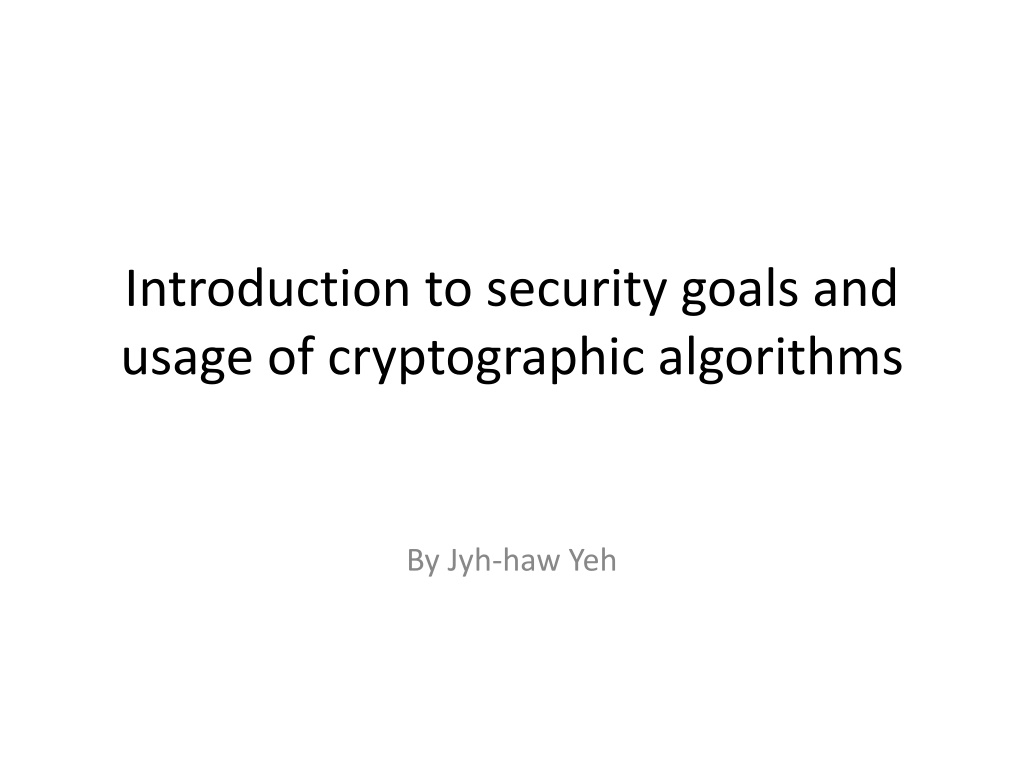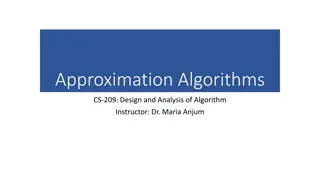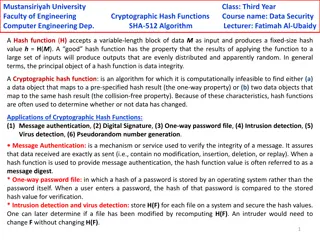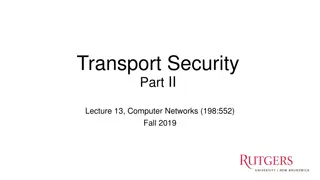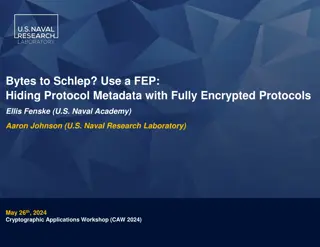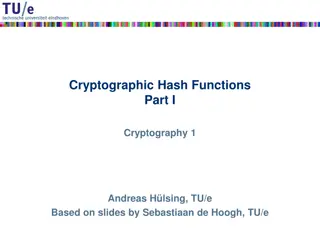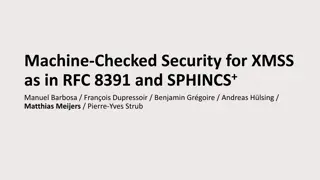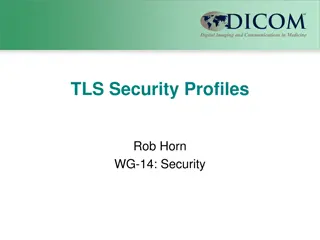Understanding Security Goals and Cryptographic Algorithms
Introduction to security goals such as privacy, data integrity, authentication, authorization, and availability, along with the usage of cryptographic algorithms like symmetric and asymmetric key algorithms, keyed hashing, and digital signatures for achieving different security objectives in communication scenarios.
Download Presentation

Please find below an Image/Link to download the presentation.
The content on the website is provided AS IS for your information and personal use only. It may not be sold, licensed, or shared on other websites without obtaining consent from the author. Download presentation by click this link. If you encounter any issues during the download, it is possible that the publisher has removed the file from their server.
E N D
Presentation Transcript
Introduction to security goals and usage of cryptographic algorithms By Jyh-haw Yeh
Security Goals Privacy: hiding confidential information. Data integrity: ensure data is origin and not forged. Authentication: ensure who you talk to is really the person he/she claimed. Authorization: authorize who should access what objects with what access privileges (read, write, execute, access right delegation, etc). Availability: services/resources are available at the time users make requests.
Cryptographic Algorithms and Usage Encryption: E(message) = cipher; D(cipher) = Message Symmetric (secret) key algorithm: both parties share a secret key Both Alice and Bob share a secret key Alice uses the key to encrypt the message and sends the cipher to Bob Bob uses the same secret key to decrypt the message Asymmetric (public key) key algorithm: both parties have their own (public, private) key pair Both Alice and Bob have a (public, private) key pair Alice uses Bob s public key to encrypt a message and send the cipher to Bob Bob can use his own private key to decrypt the message Question: What security goal(s) can be achieved?
Cryptographic Algorithms and Usage Keyed Hash: H(key|message) = digest Many to one mapping One-way function (not reversible) Change a bit in the input, then the output will be very different Given a message, hard to find a message with the same digest Hard to find two messages with the same digest Communication scenario, assume Alice and Bob share a secret key K Alice computes H(K|message) = digest Alice sends both the message and the digest to Bob Team discussion: If Bob would like to ensure the message he received is original and not forged, what actions he needs to do? Question: What security goal(s) can be achieved?
Cryptographic Algorithms and Usage Signature: usually use asymmetric key algorithm to sign a message. Alice uses her private key to sign a message and everybody can use Alice s public key to recover the message from the signature. Not knowing someone s private key, you can not forge his/her signatures Communication scenario Alice uses her private key to sign a message Alice sends the message along with her signature to Bob Team discussion: What actions Bob needs to do to verify Alice s signature? What security goal(s) can be achieved?
Cryptographic Algorithms and Usage Challenge and response: Alice and Bob share a secret key K in advance. Alice sends a message {I m Alice} to Bob. Bob sends a challenge {E(1234, K)} to Alice. Alice sends the response {1234} and her own challenge {E(9876, K)} to Bob. Bob sends the response {9876} to Alice. What security goal(s) can be achieved?
Cryptographic Algorithms and Usage For challenge & response, Try to describe the C&R back-and-forth messages between Alice and Bob if using a public key cryptographic algorithm, assuming both Alice and Bob know each other s public key? Try to describe the C&R back-and-forth messages between Alice and Bob if using a cryptographic hash algorithm, assuming Alice and Bob share a secret key?
Security principles Question: using appropriate cryptographic algorithms in applications to achieve security goals without having to know the details of how these algorithms implemented, which security principle(s) applies to this crypto- algorithm usage?
Legendary Cipher: Pigpen Code Well-known encryption algorithm without secret key. Not cryptographically strong! What s the pigpen code for goodfeel ? Activity: form teams with only two members each team. Send a short cipher to your teammate for decryption (decipher).
Legendary Cipher: Caesar Cipher (A Substitution Cipher) Rot1 to Rot25 for the lower case alphabets. For example, in Rot 2, a -> c, b->d, c->e y->a, z->b. Well-known encryption algorithm with a secret key. Not cryptographically strong! Question: what is the encryption key? Question: what is the Rot2 cipher for goodfeel ? Activity: Agree with a secret key with your teammate (1-25). Send a short cipher to your teammate for decryption (decipher)
Legendary Cipher: Random Cipher Agree with your teammate a random one-time pad first. For example, a random permutation of the lower case alphabets. The encryption/decryption algorithm: mapping each char to the corresponding char in the permutation. For example a b c d e f g . y z p l r a k c m v h Question: what is the encryption key? Question: Not secure, why not?
Secure Random Cipher The random cipher can be cryptographically secure if It is a bit-wise one-time pad and Two parties are able to securely agree on the one- time pad with enough length
